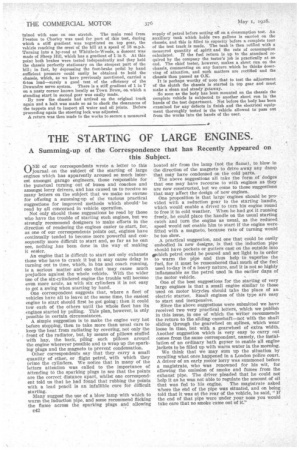THE STARTING OF LARGE ENGINES.
Page 64

If you've noticed an error in this article please click here to report it so we can fix it.
A Summing-up of the Correspondence that has Recently Appeared on this Subject.
ONE of our correspondents wrote a letter to this journal on the subject of the starting of large engines which has apparently aroused so much interest amongst garage engineers, those responsible for the punctual turning out of buses and coaches and amongst lorry drivers, and has caused us to receive so many letters on the subject that we make no excuse for offering a summing-up of the various practical suggestions for improved methods which shouldbe read by all concerned in vehicle operation.
Not only should these suggestions be read by those who have the trouble of starting such engines, but we strongly recommend designers to make efforts in the direction of rendering the engines easier to start, for, as one of our correspondents points out, engines have continually tended to become more powerful and consequently more difficult to start and, so far as he can see, nothing has been done in the way of making it easier.
An engine that is difficult to start not only exhausts those who have to crank it but it may cause delay in turning out to time, which, in bus and coach running, is a serious matter and one that 'may cause much prejudice against the whole vehicle. With the wider use of the six-cylindered engine the trouble will become even more acute, as with six cylinders it is not easy to get a swing when starting by hand.
One correspondent suggests that, where a fleet of vehicles have all to leave at the same time, the easiest engine to start should first be got going; then it could tow each of the others until the whole fleet has its engines started by pulling. This plan, however, is only possible in certain circumstances.
A simple suggestion is to make the engine very hot before stopping, then to take more than usual care to keep the heat from radiating by covering, not only the front of the radiator, but, by means of pillows stuffed with hay, the back, piling such pillows around the engine wherever possible and to wrap up the sparking plugs and the magneto to prevent condensation.
Other correspondents say that they carry a small quantity of ether, or flight petrol, with which they prime the cylinders. We notice that in many of the letters attention was called to the importance of attending to the sparking plugs to see that the points are the correct distance apart, whilst one correspondent told us that he had found that rubbing the points with a lead pencil is an infallible cure for difficult starting.
Many suggest the use of a blow lamp with which to warm the induction pipe, and some recommend flicking the flame across the sparking plugs and allowing
c42 heated air from the lamp (not the flame), to blow in the direction of the magneto to drive away any damp that may have condensed on the cold parts.
The above suggestions all take the form of dodges that one may have recourse to with engines as they are now constructed, but we come to those suggestions that may affect the design of new engines.
One proposition is that large "engines should be provided with a reduction gear to the starting handle, which would enable a driver to turn his engine round to free it in cold weather. When he had got it running freely, -he could place the handle on the usual starting catch and turn the engine as usual, as the reduced speed would not enable him to start if the engine were fitted with a magneto, because rate of turning would be too slow.
A practical suggestion, and one that could be easily embodied in new designs, is that the induction pipe should have pockets or gutters cast on the outside into eshich petrol could be poured and set light to in order to warm the pipe and thus help to vaporize the fuel, for it must be remembered that much of the fuel used to-day is of a heavy nature, and it is not so highly inflammable as the petrol used in the earlier days of the motor vehicle.
One of the best suggestions for the starting of very large engines is that a small engine similar to those used on motor bicycles should take the place of an electric starter. Small engines of this type are easy to start and inexpensive.
Since the above suggestions were submitted we have received two very practical letters, which we publish in this issue, in one of which the writer recommends the return to the sliding_ camshaft—not with the shaft sliding through the gearwheel on splines, which wear loose in time, but with a gearwheel of extra width. Another suggestion which is very easy to carry out comes from the same correspondent, namely, the installation of an ordinary bath geyser to enable all engine jackets to be filled up with warm water in the morning.
We think that we may sum up the situation by recalling what once happened in a London police court. A driver of an early motor lorry was summoned before a magistrate, who was renowned for his wit, for allowing the emission of smoke and fumes from the exhaust pipe. The driver pleaded that he could not help it as he was not able to regulate the amount of oil that was fed to his engine. The magistrate asked where the end of the pipe was situated, and on being told that it was at the rear of the vehicle, he said, "If the end of that pipe were under your nose you would take care that no smoke came out of it."












































































































